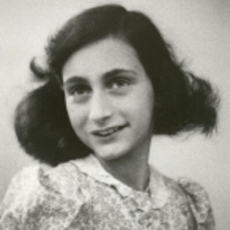
I’ve written a lot about Anne Frank recently, as I’ve visited her house and have only just finished reading her diary. Anne Frank is probably the most famous and well-known victim of the Holocaust, but of course all the other millions of lives that were lost are equally tragic. But Anne Frank provides us with a figure we can use to express our grief – someone who represents all the other victims. We can’t mourn 6 million people, so by pinning our feelings onto one life story, Anne Frank’s diary has come to represent something bigger than even Anne’s imagination could muster.
Anne was born to Otto and Edith Frank, in Frankfurt (the fact they have similar names makes it easier to remember), Germany. Her family were liberal Jews, and her community lived in harmony with non-Jewish citizens. However, as Hitler’s popularity grew, this harmony was breaking down. Anne Frank’s parents became rightly concerned about what would happen if they stayed in Germany, so Anne and her sister lived with their grandmother in a town near the Belgian border. Anne’s father received an offer to run a spice company in Amsterdam, which he accepted, and so the family reunited in the Netherlands in 1934.
At school, Anne had quite a few friends. One of them was called Hanneli Goslar, and later on Anne had a disturbing dream that Hanneli was begging her to rescue her from some sort of hell. Oddly, Anne and Hanneli were in the same concentration camp, but it was Anne that received help from Hanneli. Anne was quite an outspoken young lady, and had no problem voicing her opinions. She wasn’t as studious or clever as her sister Margot, but Anne did have a talent for writing.
In her diary, Anne doesn’t write too much about her life before going into hiding. However, she seems to enjoy hanging out with her friends, complaining about teachers, and riding her bicycle round the city. She sounds like a normal teenager, doesn’t she? Well that’s because she was! A lot of her diary actively states how Anne just wants to go outside and to do the things other people her age were doing, but she’s so frustrated she isn’t allowed, all because of her religion.
In the Secret Annexe, Anne loves her father very much, but feels distant from her mother. She pretty much hates the other adults in hiding with them, but they’re not relations of the Frank family. For more about the contents of her diary, see my article on the subject.
Anne Frank was in hiding for 2 years, but one day the police turned up and arrested them. The family must have been betrayed, but nobody knows who by. They were sent to a transit camp, before they were sent away from the Netherlands and to Auschwitz concentration camp. She went to Bergen-Belsen from there, and a typhus outbreak killed both Anne (aged 15) and her sister Margot, just a few weeks before the camp was liberated by British troops. Anne’s father was the only one who survived, and he got Anne’s diary published.
Anne is inspirational, not because of a great deed, but because of the legacy she has left for future generations to learn about (and hopefully from) the Holocaust.
Image from: https://twitter.com/annefranktrust

0 Comment:
Be the first one to comment on this article.